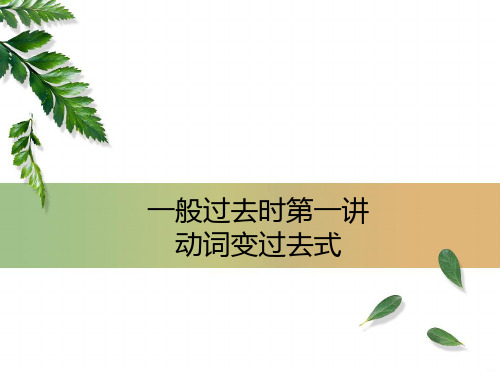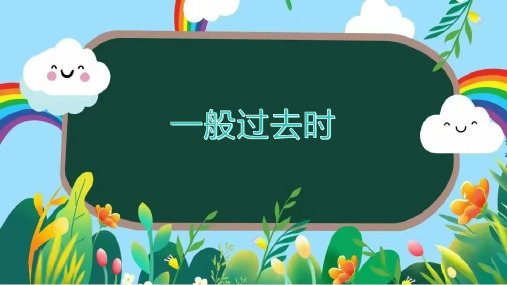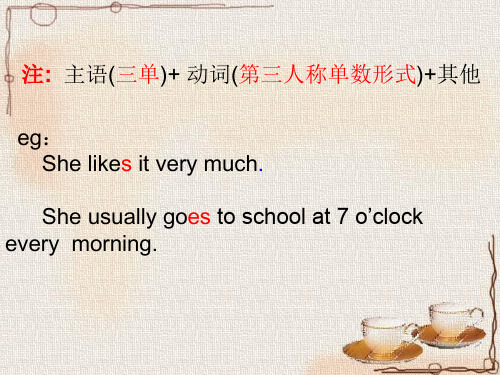一般过去时课件
一般过去时学习ppt课件

Lucy __d_id_n_’_t_ ___d_o___ her homework at home. 2、He found some meat in the fridge.(变一般疑问句)
__D_i_d__ he __f_in_d_ ___a_n_y_ meat in the fridge? 3、She stayed there for a week.(对划线部分提问)
2、His father worked all day last Monday.(改一般疑问句) __D_i_d__his father ___w_o_r_k__ all day last Monday?
3、 I was very busy last week. (改否定句和一般疑问句) I __w__as_n_’_t_ very busy last week. _W__er_e_ you very busy last week?
2. 结尾是 e 的动词加 -d
3. 末尾只有一个辅音字母的重读 闭音节词,先双写这个辅音字 母,再加-ed
look play start live hope use
stop plan trip
looked played started lived hoped used
stopped planned tripped
/t/ /d/ 之后念 /id/ , 即 ed 在 /t/ /d/ 音后面念 /id/
例:wanted shouted needed counted
“雪亮工程"是以区(县)、乡(镇) 、村( 社区) 三级综 治中心 为指挥 平台、 以综治 信息化 为支撑 、以网 格化管 理为基 础、以 公共安 全视频 监控联 网应用 为重点 的“群 众性治 安防控 工程” 。
一般过去时讲解PPT课件

Yes,you did.
Yes,I did. Yes,he/she/it did.
No,you did not. No, I did not. No,he/she/it did not.
work Did we work?
Did you work? Did they work?
Yes,we/you did. Yes,we did. Yes,they did.
grow -- grew know -- knew throw -- threw blow -- blew write -- wrote drive -- drove ride -- rode get -- got forget -- forgot lend -- lent send -- sent spend -- spent say -- said */sed/ pay -- paid stand -- stood understand -- understood let -- let put -- put cut -- cut read -- read2*0
.
1
1.定义:
(用法一) 一般过去时态表示过去某个时间发生的动 作或存在的状态,常和表示过去的时间状语连用;
eg:I got up at 7:00 yesterday.
My father was at work yesterday afternoon
(用法二) 也表示过去经常或反复发生的动作,常和 表示频度的时间状语连用。
写出下列动词的过去式:
go
went
use
think thought live
be
was/ were wake
happen happened keep
一般过去时(12张PPT)初中英语专项复习课件

一般过去时 初中英语专项分析
一般现在时 de 应用场景
过
动作行为
去
发
生
曾经
的
存在的状态
识别 标志词 理解 句意
答题技巧
熟练 动词 转换
yesterday last week 3 days ago
动词 过去式
熟练 句型 转换
肯定 否定 疑问
一般 过去时 He played basketball yesterday.
yesterday? Yes, I did. No, I didn’t.
动词 过去式 形态的变化
一般
直接加 ed
二般
以 e 结尾,去 e 加 ed live dance hope use
动词 过去式 形态的变化
三般
重读辅元辅,双写尾字母
stop plan
四般
辅音字母 + y 结尾,把 y 变 i 加 ed cry study worry
标志词
时间状语:last night, yesterday, the day before yesterday last week, some years ago in 1995, the other day, just now, in the past
小学英语时态之 一般过去时讲解课件ppt

一般过去时:
定义: 一般过去时,是表示过去某一时刻或某一段时间内发生的动作或存在
的状态。
标志词: yesterday, just now, …ago, last…, this morning …
结构: 谓语是be动词
谓语是行为动词
肯定句: 主语+ was/were + 其他 否定句: 主语+ was/were + not + 其他 一般疑问句: Was/Were + 主语+其他? 肯定句: 主语+ 动词的过去式 + 其他 否定句: 主语+ didn’t +动词原形 + 其他 一般疑问句:Did + 主语+ 动词原形 +其他?
at the weekends this morning often
usually
last Mid-Autumn Festival
every day three days ago on Mondays
tomorrow a moment ago 14 years ago
找出表示一般过去时的时间副词。
( B) 1. My mother had breakfast and____to work.
A. go B. went C. going D. to go
( A)2. -- How __ your vacation?
-- It was pretty good. A. was B. were C. did D. do
( )3.Each student one picture.
A.draw B. draws C. drawing D.to drawing
一般过去时课件(PPT)课件

用动词的适当时态填空
____ you ________ (remember) to buy the oranges yesterday? 2.Who ________ (play) computer games yesterday. 3.We _____ (go) to the cinema last night. The film _____ (be) very good. 4.What time ____ you ____ (get) to school this morning? 5.Jim ___ (do) a lot yesterday. He ____ (go) shopping and ______ (cook) supper.
lived
ate
had
made
played
cooked
Did
规则变化 1.一般加ed
2.以e结尾加d
3.末尾只有一个辅音字母的重读闭音节词,先双写这个辅音字母,再加ed .
work —
worked
change —
changed
prefer —
preferred
stop —
stopped
study —
didn’t do
Did
find any
How long did
stay
Was
any
Thank you
CLICK HERE TO ADD A TITLE
单击此处添加文本具体内容
演讲人姓名
do/ does
didn’t
did
didn’t watch
小学一般过去时教学课件

小学一般过去时教学课件2023-10-26contents •一般过去时的定义和特点•一般过去时的基本用法•一般过去时的常见形式•一般过去时的句型和用法•一般过去时的特殊用法及注意事项目录01一般过去时的定义和特点一般过去时是一种动词时态,表示过去某个时间发生的动作或状态。
定义一般过去时由动词的过去式构成,规则动词的过去式是在动词后加上-ed,例如walk→walked,play→played。
不规则动词则需要单独记忆,例如go→went,do→did。
构成时间指向一般过去时的时间指向是过去,它描述的是过去某个时间发生的动作或状态。
语法结构一般过去时的语法结构是动词的过去式,通过加-ed来构成。
表达方式一般过去时可以用在陈述句、疑问句和否定句中,例如I walkedto school yesterday(我昨天走路去学校)。
02一般过去时的基本用法1表示过去的动作或状态23描述过去发生的动作或状态,例如:昨天我去了公园。
描述已经完成的动作或状态,例如:我已经吃过午饭了。
描述持续到过去的动作或状态,例如:他去年住在北京。
描述过去某人在某事上的经历或经验,例如:我去年去过长城。
描述过去的感受或体验,例如:他昨天很开心。
描述过去对某事物的看法或经历,例如:他以前喜欢看动画片。
表示过去的经历或经验表示过去的比较或对比02描述过去两个时间之间的比较或对比,例如:昨天比前天热。
03描述过去两个地点之间的比较或对比,例如:北京比上海繁华。
03一般过去时的常见形式主语+was/werebe动词的一般过去时形式肯定句形式主语+was not/were not否定句形式Was/Were+主语一般疑问句形式do/does的一般过去时形式肯定句形式:主语+did否定句形式:主语+did not一般疑问句形式:Did+主语肯定句形式:主语+had否定句形式:主语+had not一般疑问句形式:Had+主语have/has的一般过去时形式04一般过去时的句型和用法总结词表示“存在”或“位置”。
英语一般过去时PPT课件

live hope use
lived hoped used
6
3.重读闭音节词, 先双写这个辅音字母,再加—ed
stop plan
stopped planned
7Байду номын сангаас
4. 以“辅音字母+y”结尾的词, 先变“y”为“i”再加—ed
study worry
studied wd orrie
8
不规则动词 过去式的构成
was were did
went had made got
eat
say see stand find
ate
said saw stood found
18
Play Played
19
use used
20
plan planned
21
study studied
22
worry worried
23
stop stopped
一般过去时第一讲 动词变过去式
past no w
futur e
2
动词过去式 的构成
规则动词
regular verbs
不规则动词
irregular verbs
3
规则动词 过去式的构成
1、一般在动词末尾加– ed
look play start
looked played started
5
2、结尾是 e 的动词只加 -- d
否定句: →She didn’t play the violin last night.
肯定句: They swam in the lake yesterday.
否定句: →They didn’t swim in the lake yesterday.
一般过去时公开课优秀课件pptx

课程总结
回顾本节课的重点和难点,鼓 励学生在日常生活中积极运用 一般过去时进行交流
02 一般过去时基本概念
定义及作用
定义
一般过去时表示过去某个时间里 发生的动作或状态。
作用
用于描述过去发生的事情,表达 过去的经历、状态或情感。
构成形式
01
was/were + 动词的过去分词( 用于第一、三人称单数和第二人 称)
03 一般过去时用法详解
表示过去某个时间里发生的动作或状态
动作发生在过去
用一般过去时表示在过去某个时间里 发生的动作或状态,句中常有明确的 时间状语。例如:yesterday, last week, an hour ago等。
状态在过去存在
除了表示动作外,一般过去时还可以 表示过去存在的状态。例如:I was at home yesterday.(我昨天在家。)
与过去进行时的对比
动作进行与完成
一般过去时表示过去某个时间点 完成的动作,而过去进行时强调 过去某个时间点正在进行的动作
。
动词形式
一般过去时使用动词的过去式, 而过去进行时使用“was/were
+ 现在分词”的形式。
语境差异
一般过去时适用于描述单一、完 整的动作,而过去进行时适用于 描述背景、持续的动作或同时发
达。
鼓励同学们多读书、多看电影 、多听音乐,不断拓展自己的 视野和知识面,提高自己的跨 文化交际能力。
期待在下一次的课程中与大家 再次相聚,共同探讨英语学习 的乐趣和奥秘。
THANKS
04
例句:When I was a child, I often played football in the street. ( 当我还是个孩子的时候,我经常在街上踢足球。)
一般过去时(课件)

一般过去时(课件)一般过去时是英语中表达过去某个时间点或时间段发生的动作或状态的一种时态。
在一般过去时中,动词的形式需要根据主语的人称和数进行变化。
一般过去时的句型结构是:主语 + 动词过去式 + 其他。
一、一般过去时的构成1. 规则动词:在动词原形的基础上加上ed。
例如:work → worked, play → played, study → studied。
二、一般过去时的用法1. 表示过去某个时间点发生的动作。
例如:I went to the library yesterday.2. 表示过去某个时间段内发生的动作。
例如:We playedfootball last weekend.3. 表示过去某个时间段内的状态。
例如:She lived in New York for five years.4. 表示过去习惯性动作。
例如:He used to smoke when he was young.三、一般过去时的疑问句和否定句1. 疑问句:将助动词did放在主语之前,动词原形放在助动词之后。
例如:Did you watch the movie last night?2. 否定句:在主语和动词之间加上助动词did,动词原形变成动词的过去式,并在动词过去式前加上not。
例如:I didn't finish my homework yesterday.四、一般过去时的特殊用法1. 过去进行时:表示过去某个时间点正在进行的动作。
例如:What were you doing at 8 o'clock last night?2. 过去完成时:表示在过去某个时间点之前已经完成的动作。
例如:I had finished my work before he came.3. 过去完成进行时:表示在过去某个时间点之前一直在进行的动作。
例如:She had been waiting for two hours when he finally arrived.一般过去时(课件)一般过去时是英语中表达过去某个时间点或时间段发生的动作或状态的一种时态。
一般过去时讲解课件(共19张PPT).ppt

否定句
1) 主语+wasn’t/weren’t+表语
He wasn’t a student ten years ago.
2) 主语+didn’t+动词原形+其他
They didn’t have a good time last night.
4.一般过去时的结构
一般疑问句
was为单数; were为复数
一般过去时的结构
4.一般过去时的结构
was为单数; were为复数
肯定句
1) 主语+was/were+表语
He was a student ten years ago.
2) 主语+动词过去式+其他
They had a good time last night.
4.一般过去时的结构
was为单数; were为复数
时间+ago类 in+年份类
yesterday morning;yesterday.... last night; last week...
two days ago in 2023
动词过去式的变化
3.动词过去式的变化 1.直接加ed work--worked look--looked 2.不发音的e结尾,去e加ed hope--hoped like--liked 3.重读的闭音节词,双协结尾字母加ed stop--stopped plan--planned 4.以辅音字母加y结尾,变y为i再加ed study--studied try--tried 5.不规则变化
What did they do last night?
总结与练习
5.总结与练习
一般过去时 1.定义:表示一个过去发生的动作或表示过去存在的状 态 2.标志词:yesterday,last...,....ago, just now..... 3.动词的过去式变化 4.一般过去时的各种句型:
一般现在时和一般过去时ppt课件

carryies do es wash es visit s exercise s enjoy s jump s hhaavse
一般现在时否定式
be + not don’t do / doesn’t do
II 一般现在时的否定式
1.Be 动词的否定式: be + not
I am a teacher.
把下列句子改为否定句
1.My father has an egg for breakfast . My father doesn’t have an egg for breakfast .
2.Li Lei does his homework after school. Li Lei doesn’t do his homework after school.
1. We often __p_la_y_ (play) in the playground. 2. He _g_et_s_ (get) up at six o’clock. 3. _D_o_ you b_r_u_s_h (brush) your teeth every morning? 4. What d_o_e_she usually_d_o_ (do) after school? 5. Danny_s_t_ud_i_e_s (study) English, Chinese, Maths, Science and Art at school. 6. Mike sometimes _g_o_es__(go) to the park with his sister. 7. She w_a_t_ch_e_s (watch) TV with his parents every evening. 8.D__oe_s_ Mike _r_ea_d_(read) English every day?
小学一般过去时ppt课件

常与表示过去的时间状语连用
如yesterday, last week等。
2024/1/26
8
肯定句使用场景举例
1 2
描述过去发生的事情
如"I went to the park yesterday."(我昨天去 了公园)。
表达过去的习惯或经常性动作
如"She always walked to school when she was young."(她年轻时总是步行去学校)。
5
时间状语及标志词
2024/1/26
时间状语
yesterday,last week,an hour ago等。
标志词
ago(以前),just now(刚才 ),then(那时)等。
6
PART 02
肯定句结构与用法
REPORTING
2024/1/26
7
肯定句结构特点
主语 + 动词过去式
表示过去某个时间发生的动作或状态。
式。
注意动词变化
掌握规则动词和不规则动词的 过去式变化,避免使用时出现
错误。
结合语境理解
在阅读和听力练习中,结合上 下文语境理解一般过去时的用
法。
模仿和练习
通过模仿和练习,逐渐熟练掌 握一般过去时的运用技巧。
2024/1/26
26
THANKS
感谢观看
REPORTING
2024/1/26
27
疑问句句尾语调上升。
2024/1/26
16
疑问句使用场景举例
对过去发生的事情进行提问。
2024/1/26
对过去某个时间点的状态进行 提问。
对过去某个时间段内发生的动 作进行提问。
一般过去时课件(PPT)

1.Lucy did her homework at home. (改否定句) do Lucydidn’t ___ ____ her homework at home. 2.He found some meat in the fridge. (变一般疑问句) Did ___ he find ___ any ____ meat in the fridge? 3.She stayed there for a week. (对划线部分提问) ____ ____ _____ there? How long did____ she stay 4.There was some orange in the cup. (变一般疑问句) Was there ____ any orange in the cup? ____
用动词的适当时态填空
Did you remember 1.____ ________ (remember) to buy the oranges yesterday? 2.Who played ________ (play) computer games yesterday. went 3.We _____ (go) to the cinema last was night. The film _____ (be) very good. did 4.What time ____ you get ____ (get) to school this morning? did 5.Jim ___ (do) a lot yesterday. He went (go) shopping andcooked ____ ______ (cook) supper.
行为动词一般过去时的疑问式
一般过去时的特殊疑问式 疑问词+did+主语+动词原形……? They finished their work at four. B A
一般过去时讲解PPT课件

did
助动词,用于构成一般过去时的 疑问句和否定句。
主语
句子中的动作执行者,可以是名 词、代词等。
例如
What did you do yesterday? 你 昨天做了什么?
其他成分
包括宾语、状语等,根据句子需 要而定。
动词原形
指动词的基本形式,即不加任何 时态或语态标记的形式。
特殊疑问句实例分析
when、after、 before、as等引导的 表示过去的时间状语 从句。
已经、曾经、刚才、 那时等表示过去的时 间副词。
02
一般过去时肯定句结构
主语+动词过去式+其他成分
01
02
03
主语
句子中的主体,可以是人 、物或抽象概念。
动词过去式
表示过去某个时间里发生 的动作或状态。动词的过 去式可分为规则变化和不 规则变化两种。
表示过去某个时间里发生的动 作或状态。
用法
陈述过去的事实或情况,描述 过去经常或反复发生的动作。
现在完成时
表示过去发生的动作对现在造 成的影响或结果,或从过去已 经开始,持续到现在的动作或 状态。
用法
强调过去与现在的联系,表达 一个动作从过去一直延续到现
在。
两者在时间状语上的区别
01
02
03
04
一般过去时
一般过去时讲解PPT课件
目录 Contents
• 一般过去时基本概念 • 一般过去时肯定句结构 • 一般过去时否定句结构 • 一般过去时疑问句结构 • 一般过去时特殊疑问句结构 • 一般过去时与现在完成时的比较
01
一般过去时基本概念
定义与作用
定义
一般过去时表示过去某个时间里 发生的动作或状态。
语法:一般过去时 复习课件(共43张ppt)

行为动词的一般过去时肯定句结构 主语+动词的过去式+其他
烹调
餐;饭 菜
cook the meals s
我 昨天做饭了。
[ kʊk ]
做 饭
I cooked the meals yesterday .
clean
打 扫
[kli:n]
clean the bedroom
昨晚我打扫卧室了
打扫卧室
I cleaned the bedroom last night.
时间决定时态,动词体现时态。
规则动词
regular verbs
动词过去式 的构成 不规则动词
irregular verbs
规则动词 过去式的构成
巧记动词过去时形式-ed的变化:
变化规则:动词变化很好记,一般末尾加 -ed。如果词尾有个e紧跟其后加个d。辅 音字母若加y,先要把y变i,特殊变化要 熟记,保你一定考第一。
be动词的一般过去时否定句结 构:
主语+was/were+not+其他 1. I was fat then.
2.They were thin then.
3.He was happy yesterday. 4.You were ten last year.
1.把was, were放在句首,其余位 置不变。
2.与yesterday 连用:
yesterday
morning afternoon evening
the day before yesterday
一般过去时分两种情况: 1.be动词的一般过去时 2.行为动词的一般过去时
be动词的一般过去时: be动词包括:am,is,are is,am(过去式) was are(过去式) were
一般过去时(复习)公开课PPT课件

以辅音字母+y结尾的动词,把y变为i 再加-ed,如:study—studied。
以不发音的e结尾的动词,动词词尾 加-d,如:live—lived。
以一个辅音字母结尾的重读闭音节动 词,双写词尾辅音字母,再加-ed, 如:stop—stopped。
创造英语环境
在日常生活中尽量使用英 语,提高英语的实际运用 能力。
鼓励学生在日常生活中运用一般过去时
记录日常活动
用英语记录自己一天的活 动,使用一般过去时描述 过去发生的事情。
讲述经历
和同学或家人分享自己的 经历,使用一般过去时讲 述故事。
看图说话
选择一张图片,使用一般 过去时描述图片中的人物 和事件。
通过给出句子和选项,让学生选择正确的动词过去式完成句子。
改写句子
提供现在时的句子,要求学生将其改写为一般过去时。
连词成句
给出打乱顺序的单词,让学生重新排列并加上适当的标点符号,形 成语法正确、意思完整的句子。
小组讨论并分享经验
分组讨论
学生分组,每组围绕一个与一般过去时相关的话题展开讨论,如“你昨天做了什 么?”或“你曾经去过哪些地方?”。
常见误区及注意事项
不规则动词的过去式需要特殊记忆,不能简单地加-ed,如:go—went, eat—ate等。
在使用一般过去时时,要注意动词的过去式与过去分词的区分,避免混 淆。
在表达过去发生的动作时,要注意时间状语的正确使用,确保时态的一 致性。
03
一般过去时在句子中运用
陈述句中使用一般过去时
讲解一般过去时在各种句式中的 表达方式,如肯定句、否定句、 疑问句等,并给出相应的例句。
一般过去时公开课优秀课件小学一般过去时优秀课件

在写作中的应用
总结词
在写作中,一般过去时常常用来描述故事、事件或个人经历等过去的事情,使叙述更加 生动和有说服力。
详细描述
在写作中,特别是记叙文、小说、回忆录等文体中,一般过去时被广泛使用。通过使用 一般过去时,作者可以生动地描绘过去的事件、人物和场景,让读者更好地感受到故事 的情感和情节。同时,一般过去时也可以用于描述历史事件和事实,使叙述更加客观和
用于描述已经发生的 事情,例如:昨天我 去了公园。
一般过去时的基本形式
01
02
03
04
动词形式变化
规则动词和不规则动词的过去 式形式。
时间状语
通常与表示过去时间的状语连 用,如yesterday, last week
等。
否定形式
在动词前加助动词did not (didn't) 或 didn。
疑问句形式
感谢您的观看
THANKS
填空练习
提供缺少动词的句子,让 学生填写正确的过去时态 动词。
选择题
列出多个动词,让学生从 中选择正确的过去时态形 式。
改错题
提供含有错误过去时态的 句子,让学生进行纠正。
语境练习
情境对话
设置一个特定的情境,让 学生使用过去时态进行对 话。
故事编写
让学生编写一个以过去时 态为主的故事,强调时态 的正确使用。
一般过去时公开课优 秀课件
汇报人:可编辑
2023-12-24
目录
CONTENTS
• 一般过去时的定义 • 一般过去时的用法 • 一般过去时的常见错误 • 一般过去时的练习 • 一般过去时的实际应用
01 一般过去时的定义
什么是一般过去时
一种描述过去事件或 状态的时态。
- 1、下载文档前请自行甄别文档内容的完整性,平台不提供额外的编辑、内容补充、找答案等附加服务。
- 2、"仅部分预览"的文档,不可在线预览部分如存在完整性等问题,可反馈申请退款(可完整预览的文档不适用该条件!)。
- 3、如文档侵犯您的权益,请联系客服反馈,我们会尽快为您处理(人工客服工作时间:9:00-18:30)。
He played the piano
Yesterday!
piano
2020/11/12
did my homework played soccer
cleaned my room went to the beach played tennis
Played volleyball
What did she do yesterday?
She played volleyball Yesterday!
2020/11/12
Go swimming
Went swWimhmaitngdid they They wendt oswyimemsitneg rday?
yesterday!
2020/11/12
Go to the movies Went to the movies
What did she do yesterday?
She went to the movie Yesterday!
2020/11/12
What did he do yesterday?
watched TV
had a party
2020/11/12 played tennis
went to the beach
Watch TV
Watched TV What did he do yesterday?
He watched TV Yesterday!
2020/11/12
Play volleyball
What did he do yesterday?
Did his homework He did his homework yesterday!
2020/11/12
What did he do yesterday?
Visited my friends
He visited his friend yesterday!
2020/11/12
Go to the
beach
Went to the beach
What did he do yesterday?
He went to the beach yesterday!
Beach
2020/11/12
Play the piano
Played the piano What did he do yesterday?
had
我今年学英语 I _s_tu__d_y English this year.
我去年学日语。 I studieJdapanese last year.
他现在住在北京。 He livesin Beijing now.
他去年住在上海。 He livedin Shanghai last year. 他们现在在中国工作。They workin China now. 2009年他们在日本工作。
played basketball
play the guitar
played the guitar
2020/11/12
play computer
played computer
Past过去
Present现在
went to the movies go to the movies
did my homework do my homework
2020/11/12
Please look at the sentences
我今年12岁. I _a_m_ 12 years old this year.
我去年11岁. I _w_a_s_ 11 years old last year.
他现在在北京。 He __is__ in Beijing now. 他昨天在上海。 He _w_a_s_ in Shanghai yesterday.
2020/11/12
他们今天在中国。 They _a_r_e_ in China today.
他们昨天在日本。 They _w_e_re_ in Japan yesterday.
am/ is are
2020/11/12
was were
每天,早餐我吃鸡蛋和牛奶。 I h_a_v_e_ eggs and milk for breakfast every morning.
played tennis
play tennis
played soccer
play soccer
cleaned the room clean the room
went to the beach go to the beach
2020/11/12
What did you / he / she / they do last weekend?
昨天,早餐我吃面条。 I _h_a_d_ noodles for breakfast yesterday morning.
他每天都吃水果。
He __h_as__ fruit every day.
昨天他吃了3个苹果。
He _h_a_d__ 3 apples yesterday.
have/ has 2020/11/12
They workeidn Japan in 2009.
小结: study studied
live lived
woret up at 6:30 every morning. I _g_ot_ up at 9:00 last Sunday.
He plays football every afternoon. He _pl_a_y_e_d basketball yesterday afternoon.
Go to the park
Went to the park
He went to the park yesterday!
2020/11/12
park
What did she do yesterday?
Cleaned her room
She cleaned her room yesterday!
2020/11/12
He does his homework every evening.
He _d_i_d_ some reading last night.
动词原形、第三人称单数 动词过去式
2020/11/12
What do you do every day?
play basketball
What did you do last weekend?
